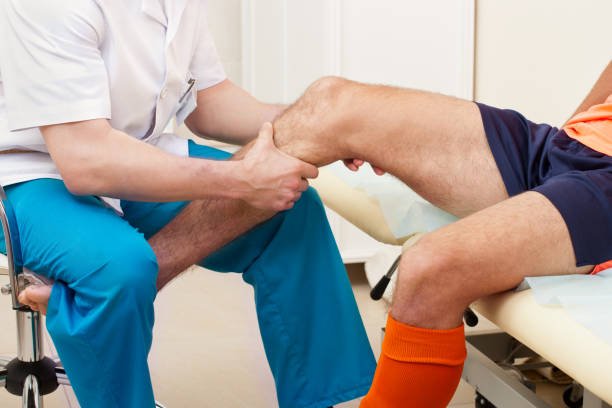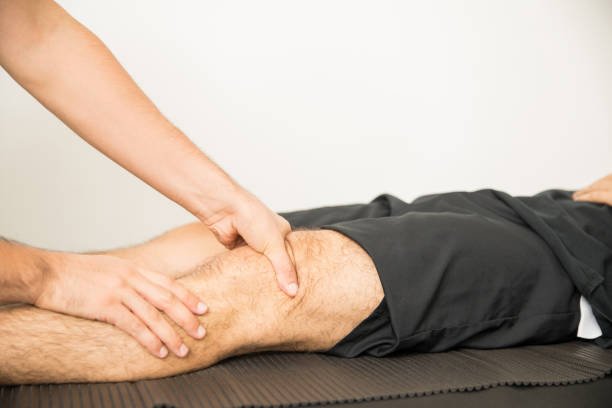therapy for Knee Pain: Your Complete Guide to Recovery and Prevention
Sports Physiotherapy for Knee Pain: Your Complete Guide to Recovery and Prevention by Humza Physiotherapist & Soft Tissue Release Therapist.
Sports physiotherapy transforms knee pain into strength—learn how targeted treatment can get you back in the game.

Introduction
Three months ago, I couldn’t walk down stairs without wincing. As a weekend warrior who’d pushed through one too many tennis matches, my left knee finally said “enough.” That’s when I discovered the game-changing difference sports physiotherapy could make—not just for professional athletes, but for anyone committed to staying active.[1][2]
Knee pain affects millions worldwide, with athletes experiencing injury rates of up to 60% during their careers. Whether you’re a dedicated sports professional training for competition or someone with a sedentary lifestyle trying to get moving again, knee pain doesn’t discriminate. The good news? Sports physiotherapy offers a scientifically-backed pathway to recovery that goes far beyond traditional treatment methods.[3][4][5][6]
Understanding Sports Physiotherapy vs. Traditional Treatment

Sports physiotherapy represents a specialized branch of healthcare that combines cutting-edge techniques with sport-specific knowledge to address knee pain comprehensively. Unlike general physiotherapy, which covers a broad spectrum of conditions including cardiovascular and neurological issues, sports physiotherapy focuses intensively on musculoskeletal disorders—particularly those stemming from physical activity.[2][7][8][1]
“Sports therapy offers a specialised approach to managing and alleviating knee pain, helping you regain mobility, strength, and confidence,” explains leading sports therapist Charlie from Principle Physiotherapy. This targeted approach means practitioners spend three years focusing solely on musculoskeletal injuries and rehabilitation, developing expertise that’s particularly valuable for active individuals.[8][1]
The key difference lies in the application. While traditional physiotherapy might use manual therapy primarily for pain management, sports physiotherapy utilizes these same techniques to help individuals handle intense training and competition demands—maintaining muscle health while reducing recovery time between activities.[9]
What Makes Sports Physiotherapy Unique for Knee Pain?

Sports physiotherapy addresses knee pain through a performance-focused lens. According to research published in systematic reviews, sports massage—a cornerstone technique in sports physiotherapy—can play a vital role in alleviating knee pain by targeting both muscular and joint-related issues. Studies demonstrate that sports massage offers improvements in flexibility while reducing delayed onset muscle soreness, aiding recovery after physical activity.[10]
The specialized techniques include effleurage (stroking movements), petrissage (kneading), friction, and tapotement—each serving specific purposes in knee pain management. These methods work synergistically to ease muscle tension, decrease tendon rigidity, and reduce inflammation around the knee joint.[11][12][13]
The Science Behind Knee Pain in Active Individuals
Understanding knee pain begins with recognizing the joint’s complexity. Your knee bears four times your body weight with each step, making it one of the hardest-working joints in your body. This intricate structure comprises three bones (femur, tibia, and patella), multiple ligaments, cartilage, and surrounding muscles—all vulnerable to injury.[14]
Common Knee Conditions in Sports and Sedentary Lifestyles
Patellofemoral Pain Syndrome (PFPS)

Anterior Cruciate Ligament (ACL) injuries
This is the most common cause of knee pain in young athletes, characterized by pain around the kneecap. This condition affects both highly active individuals and those with sedentary lifestyles, particularly young women. Contributing factors include weak thigh muscles, tight hamstrings, and poor foot support.[15][3]

Iliotibial Band (ITB) Syndrome commonly affects runners and cyclists, caused by friction between the ITB and the lateral femoral epicondyle. Meanwhile, knee bursitis results from inflammation of fluid-filled sacs that cushion the joint, often triggered by direct blows during contact sports.[3][4]
For sedentary individuals, osteoarthritis becomes a primary concern—a degenerative condition where cartilage wears away, leading to stiffness, pain, and reduced mobility. This condition particularly affects older adults but can impact younger individuals with previous injuries.[14]
Case Study: From Chronic Pain to Peak Performance
Consider the transformation of Roberta Lynch, a 73-year-old avid hiker who experienced severe knee swelling during downhill treks. Before seeking sports physiotherapy treatment, she relied solely on online programs and videos but wasn’t seeing the results she needed.[17]
“My knee pain was getting really severe. I walk a lot, even walking long distances, and my knees were starting to swell,” Roberta shared. After beginning targeted sports physiotherapy sessions, her results were remarkable: “Where I used to feel pain under my kneecaps, that pain is gone now just walking on flat ground”.[17]
Her success highlights a crucial principle: personalized guidance makes the difference. While general information helps, having a sports physiotherapist critique your technique and provide customized solutions accelerates recovery significantly.[17]
Professional Insights on Treatment Success
According to Mr. Damian McClelland, Trauma and Orthopaedic Consultant at Bupa, “Conservative treatment, including physiotherapy, is usually recommended as a first step to treat knee pain. This is because most people recover well using non-invasive therapy”. His perspective, backed by clinical experience, reinforces that many knee issues can be successfully managed without surgical intervention when proper rehabilitation is implemented early.[18]
Sports massage specialist research indicates that “70-80% of the cases of knee pain are functional issues that a sports massage can resolve completely”. This statistic demonstrates the potential for non-invasive treatment approaches when applied correctly.[12]
Actionable Takeaways for Managing Knee Pain
Immediate Pain Relief Strategies
Apply the POLICE principles: Protect, Optimal Loading, Ice, Compression, and Elevation provide the foundation for acute knee pain management. Ice application should occur within the first 48-72 hours after injury, followed by heat therapy for chronic conditions.[19][18]
Seek professional assessment early: Sports physiotherapists can provide accurate diagnosis through comprehensive evaluation, identifying the root cause rather than just treating symptoms. This approach prevents minor issues from becoming major problems.[20][1]
Long-term Recovery and Prevention
Focus on strengthening exercises: Target the quadriceps, hamstrings, and gluteal muscles to provide better knee support. Research shows that muscle imbalances—where one muscle group is significantly stronger than its counterpart—often contribute to knee pain development.[21][22]
Incorporate flexibility work: Tight muscles create additional stress on knee joints. Regular stretching of quadriceps, hamstrings, and calf muscles helps maintain proper joint mechanics.[23][24]
Sports Massage Techniques for Knee Pain Relief
Professional sports massage offers multiple therapeutic benefits for knee pain sufferers. These techniques include:[25][26]
- Increased blood circulation: Enhanced nutrient delivery to injured tissues accelerates healing
- Reduced muscle tension: Alleviating tightness in supporting muscles decreases joint stress
- Improved flexibility: Better range of motion reduces injury risk
- Pain management: Massage therapy stimulates endorphins while reducing pain signal transmission[26]
The key is finding a qualified practitioner who can assess your specific condition and determine appropriate treatment intensity. Some individuals with pre-existing conditions like high blood pressure or osteoporosis may need modified approaches.[26]
Conclusion
Knee pain doesn’t have to define your limitations—whether you’re an athlete or someone rediscovering an active lifestyle. Sports physiotherapy offers evidence-based solutions that address root causes rather than just symptoms, providing a pathway from pain to performance.
The combination of specialized techniques, performance-focused rehabilitation, and preventive strategies makes sports physiotherapy particularly effective for knee pain management. From immediate pain relief through sports massage to long-term strength building and movement optimization, this approach transforms how you move and feel.
Don’t let knee pain sideline your goals. The journey from limitation to liberation begins with a single step—consulting with a qualified sports physiotherapist who can guide your recovery and help you reclaim your active lifestyle.
Ready to get personalized relief? Book your sports massage session today and experience neck pain relief firsthand.
Click to book. An Appointment with Humza Physical Therapist in Manchester.
https://mysportinjury.janeapp.co.uk/#/staff_member/8
REFERENCE LIST:
⁂
- https://principlephysiotherapy.co.uk/2024/06/26/understanding-knee-pain-and-how-sports-therapy-can-help/
- https://advantage-physiotherapy.co.uk/effective-sports-physio-a-comprehensive-guide/
- https://www.jointinstitutefl.com/2024/01/19/knee-pain-in-athletes-identifying-and-managing-the-causes/
- https://www.orthohc.com/news/knee-pain-in-athletes-recognizing-and-managing-sports-related-injuries
- https://lycahealth.com/news/advice/physiotherapy-for-sports-injuries-speeding-up-recovery/
- https://baphysio.co.uk/condition/sports-injuries/
- https://the-recovery-room.co.uk/physiotherapy-vs-sports-therapy/
- https://www.theinjuryandperformanceclinic.co.uk/blog/physiotherapy-vs-sports-therapy-graduate
- https://sportsclinic.ca/sports-physiotherapy-vs-regular-physiotherapy-whats-the-difference/
- https://www.massagepractice.co.uk/how-can-sports-massage-help-for-knee-pain-and-stiffness/
- https://drstretch.co.uk/blog/unveiling-the-techniques-and-approaches-in-sports-massage
- https://mrsalussportinglab.com/can-sports-massage-cure-a-knee-injury/
- https://www.centreofexcellence.com/sports-massage-brief-guide/
- https://www.recoverphysio.co.uk/knee-pain/
- https://kidshealth.org/en/teens/runners-knee.html
- https://www.bupa.co.uk/health-information/knee-pain/knee-ligament-injury
- https://www.youtube.com/watch?v=ZqcOQaxXomI
- https://www.bupa.co.uk/newsroom/ourviews/treatment-options-knee-pain
- https://www.themedical.co.uk/blog/physiotherapy/the-complete-guide-to-knee-pain-causes-and-treatment
- https://www.wimbornewellnesscentre.co.uk/clinic/our-blog/how-sports-therapy-can-help-alleviate-knee-pain
- https://orthoinfo.aaos.org/en/diseases–conditions/adolescent-anterior-knee-pain/
- https://www.benendenhospital.org.uk/health-news/physiotherapy/understanding-knee-injuries/
- https://services.eastcheshire.nhs.uk/physiotherapy/self-help/shoulder-pain-physiotherapy-1
- https://www.zoomphysio.co.uk/post/overcoming-knee-injuries-rehabilitation-physio-techniques
- https://foreverbalancedtherapy.co.uk/sport-massage/can-sports-massage-help-knee-pain/
- https://alpha-physio.co.uk/can-sports-massage-help-knee-pain/
- https://malvernphysio.com.au/comparing-musculoskeletal-and-sports-physiotherapy/
- https://www.chesterwellnesscentre.co.uk/physiotherapy-or-sports-therapy/
- https://paulclosephysio.co.nz/benefits-of-sports-physiotherapy-and-why-to-consider-it/
- https://www.homephysio.com/blog/bouncing-back-the-benefits-of-physiotherapy-for-sports-injuries/
- https://fayepattison.com/blog/what-is-the-role-of-physiotherapy-in-sports-injury-recovery/
- https://www.osteopathyphysiotherapylondon.com/knee-pain
- https://hordercentre.co.uk/our-services/physiotherapy-treatment/knee-pain/
- https://www.drandrewdutton.com/blog/knee-injuries/
- https://kensingtonphysiobox.co.uk/what-is-sports-physiotherapy/
- https://www.thebodywiseclinic.ie/different-types-of-sports-massage-explained/
- https://yorkorthopaedics.co.uk/knee/knee-sports-injuries-and-trauma/
- https://www.petermercerstt.co.uk/blog/introduction-to-massage-techniques
- https://www.straightbackphysio.co.uk/knee-pain
- https://www.futurefit.co.uk/blog/what-is-sports-massage-guide/
- https://pmc.ncbi.nlm.nih.gov/articles/PMC7942256/
- https://greendalept.com/about-us/patient-success-stories/knee-success-stories/
- https://www.pogophysio.com.au/blog/mick-hughes/
- https://www.physio.co.uk/what-we-treat/musculoskeletal/conditions/knee/
- https://www.thekneejoint.com/testimonials
- https://www.bupa.co.uk/health-information/knee-pain
- https://www.londonmet.ac.uk/services-and-facilities/injury-and-rehabilitation-clinic/testimonials-and-partners/quotes-full-text/
- https://www.physiocure.org.uk/whats-the-difference-between-physiotherapy-and-sports-therapy/
- https://www.melbournesportsphysiotherapy.com.au/blog/2018/7-benefits-of-sports-physiotherapy
- https://www.techniquehealth.org/articles/sports-massage-and-physiotherapy
- https://www.physiotattva.com/blog/benefits-of-physiotherapy-on-enhancing-athletic-performance
- https://physiofusion.co.uk/faqs-about-sports-therapy/
- https://www.ultrasportsclinic.com/post/physiotherapy-vs-sports-therapy

